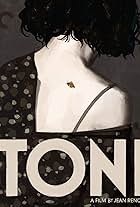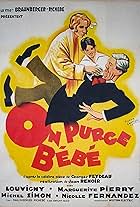IMDb RATING
6.5/10
983
YOUR RATING
Inspector Maigret investigates the mysterious murder of a Dutch diamond dealer, found dead in a stolen car. The car belongs to an insurance agent, Michonnet, and has been abandoned in the ga... Read allInspector Maigret investigates the mysterious murder of a Dutch diamond dealer, found dead in a stolen car. The car belongs to an insurance agent, Michonnet, and has been abandoned in the garage belonging to Carl Andersen.Inspector Maigret investigates the mysterious murder of a Dutch diamond dealer, found dead in a stolen car. The car belongs to an insurance agent, Michonnet, and has been abandoned in the garage belonging to Carl Andersen.
Georges Térof
- Lucas
- (as G. Terof)
Winna Winifried
- Else Andersen
- (as Winna Winfried)
Georges Koudria
- Carl Andersen
- (as George Koudria)
G.A. Martin
- Granjean
- (as Martin)
Jean Gehret
- Emile Michonnet
- (as Gehret)
Max Dalban
- Le docteur
- (as Dalban)
Roger Gaillard
- Le boucher
- (as Gaillard)
Manuel Raaby
- Guido
- (as Rabby)
- Director
- Writers
- All cast & crew
- Production, box office & more at IMDbPro
Storyline
Did you know
- TriviaGeorges Simenon was living on a houseboat when his novel was published in 1931. Very shortly afterward, he was sitting on the deck of his boat, typing a new novel, when a large car drew up on the quay to which it was moored, and a stranger got out. It was Jean Renoir, a filmmaker Simenon admired but did not know; Renoir went straight up to him and made an offer for the film rights on the spot. Simenon accepted immediately and the deal went through with no further complications-- quite possibly the quickest and most straightforward sale of film rights to a novel in movie history. The two men were lifelong friends thereafter and Simenon was devastated by Renoir's death, some 47 years later.
- ConnectionsEdited into Histoire(s) du cinéma: Une histoire seule (1989)
Featured review
This dreary film was a bad start for Simenon on the screen. Surprisingly, it was directed by Jean Renoir, who could rise to such heights as a great director, but here sank to unparalleled depths of mediocrity and dullness. It was not as if Renoir was new to directing, for he had already directed several films before this one. So there is no excuse. Because the action of the film largely takes place at night (as the title indicates), the film is literally very dark indeed. The lighting is terrible, and as it was such an early sound film, the sound is not much better. But the greatest disappointment of all is Pierre Renoir, older brother of Jean, in his role of Commissaire (Inspector) Jules Maigret. He is dull, dull, and duller. Many will remember him fondly from the later film LES ENFANTS DU PARADIS. But he was no good as a Maigret. He gives the character no personality whatsoever. A golem could have done a better job of it. Those of us who appreciate Jean Gabin and Bruno Cremer as Maigret can only sink into a slough of despond at the sight of this lifeless first screen incarnation of our hero. The Danish actress Winna Winifried, in her first screen appearance, attempts to inject some mystery into the film by her extraordinarily louche and languid performance, a deeply weird portrayal which if better exploited and directed could have worked very well indeed. She ceased work in 1940 with her seventh film, and as far as IMDb is concerned, vanished from the world after that. I wonder if the Danes could tell us more. She must have fled the Nazi invasion of Paris in that year, and who knows what might have become of her after that. She had made four French films and three British ones, none of which seems to be particularly known today, and only one has been reviewed by a single specialist reviewer, except for this one, which has been revived recently. As for the story, it is a rather meandering and feeble one, involving the smuggling of cocaine in automobile tyres. Perhaps that is why the action appears to go round in circles. Jacques Becker (father of Jean Becker), who three years later was to begin his directing career, was Production Manager. A third member of the Renoir family also worked on this film, Claude Renoir, who was focus puller. Three years later, he commenced his career as cinematographer, and only retired in 2010, after 86 films in that job. Truly the Renoir family have made their mark on French culture. Claude Renoir's most spectacular success as a cinematographer was probably, and most appropriately (considering who his grandfather was), the magnificent film about another famous painter, LE MYSTÈRE DE PICASSO (1956), directed by the brilliant Henri-Georges Cluzot. He was also the cinematographer for his brother Jean's magical and evocative film THE RIVER (1951), a classic made all the more memorable by Claude Renoir's fine work in capturing the atmosphere of India on location. It is such a pity that all these talented people could not have done a better job on this particular film, but there is no use pretending that they succeeded, because they did not. I agree with another reviewer who says that this film is 'awkward, amateurish and even inept'.
- robert-temple-1
- Jun 14, 2014
- Permalink
Details
- Release date
- Country of origin
- Languages
- Also known as
- Noc na raskrscu
- Filming locations
- Carrefour de la Croix Verte, Bouffémont, Val-d'Oise, France(The Andersens' house and garage)
- Production company
- See more company credits at IMDbPro
- Runtime1 hour 15 minutes
- Color
- Aspect ratio
- 1.20 : 1
Contribute to this page
Suggest an edit or add missing content

Top Gap
By what name was Night at the Crossroads (1932) officially released in India in English?
Answer




















